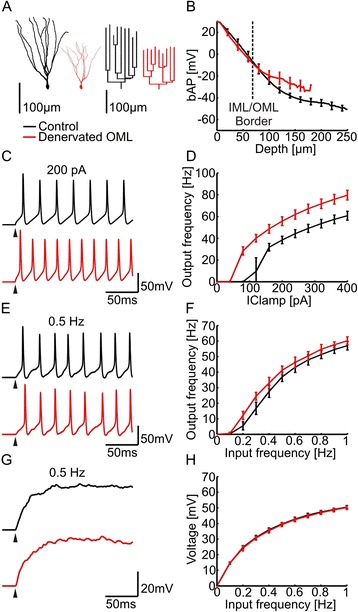Fig. 1.

Action potential backpropagation and excitability in compartmental models of denervated granule cell dendrites. a Representative examples for 3-D reconstructions of control (black) and denervated (red) GFP-positive granule cells [10]. Dendrograms of each tree are shown to the right. b Simulated action potential backpropagation (bAP) is plotted for control (black) and denervated (red) granule cells (n = 15, each) as a function of depth in the molecular layer. The border between inner and outer molecular layer is indicated by a dashed line. The IML/OML layer boundary was obtained from the reconstructed cell data. c Somatic membrane voltage traces in active compartmental models of a control (black) and a denervated (red) granule cell in response to +200 pA somatic current injections. Note an increase in the number of evoked action potentials in the denervated granule cell. d Compartmental models of denervated cells displayed higher firing rates following current injections in the soma. e Somatic membrane voltage traces in response to stochastic activation of dendritic synapses at 0.5 Hz in the active compartmental model. Excitatory synapses were distributed in dendrites of granule cells using the same synaptic density in both groups. On average 5716 and 3045 synapses were inserted in control and denervated neurons. f Corresponding firing rates in response to increasing frequency of stochastic synaptic activation. g Somatic membrane voltage traces in response to stochastic activation of dendritic synapses at 0.5 Hz in the passive compartmental model. h Corresponding steady-state voltages as a function of frequency of stochastic synaptic activation (same cells as in b)
